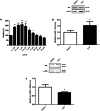A High-Throughput Chemical Screen in DJ-1β Mutant Flies Identifies Zaprinast as a Potential Parkinson's Disease Treatment
- PMID: 34697772
- PMCID: PMC8804136
- DOI: 10.1007/s13311-021-01134-2
A High-Throughput Chemical Screen in DJ-1β Mutant Flies Identifies Zaprinast as a Potential Parkinson's Disease Treatment
Abstract
Dopamine replacement represents the standard therapy for Parkinson's disease (PD), a common, chronic, and incurable neurological disorder; however, this approach only treats the symptoms of this devastating disease. In the search for novel disease-modifying therapies that target other relevant molecular and cellular mechanisms, Drosophila has emerged as a valuable tool to study neurodegenerative diseases due to the presence of a complex central nervous system, the blood-brain barrier, and a similar neurotransmitter profile to humans. Human PD-related genes also display conservation in flies; DJ-1β is the fly ortholog of DJ-1, a gene for which mutations prompt early-onset recessive PD. Interestingly, flies mutant for DJ-1β exhibit PD-related phenotypes, including motor defects, high oxidative stress (OS) levels and metabolic alterations. To identify novel therapies for PD, we performed an in vivo high-throughput screening assay using DJ-1β mutant flies and compounds from the Prestwick® chemical library. Drugs that improved motor performance in DJ-1ß mutant flies were validated in DJ-1-deficient human neural-like cells, revealing that zaprinast displayed the most significant ability to suppress OS-induced cell death. Zaprinast inhibits phosphodiesterases and activates GPR35, an orphan G-protein-coupled receptor not previously associated with PD. We found that zaprinast exerts its beneficial effect in both fly and human PD models through several disease-modifying mechanisms, including reduced OS levels, attenuated apoptosis, increased mitochondrial viability, and enhanced glycolysis. Therefore, our results support zaprinast as a potential therapeutic for PD in future clinical trials.
Keywords: Drosophila; GPR35 agonist; High-throughput screening; Parkinson’s disease; Phosphodiesterase inhibitor; Zaprinast.
© 2021. The Author(s).
Figures






Similar articles
-
Disease-Modifying Effects of Vincamine Supplementation in Drosophila and Human Cell Models of Parkinson's Disease Based on DJ-1 Deficiency.ACS Chem Neurosci. 2023 Jun 21;14(12):2294-2301. doi: 10.1021/acschemneuro.3c00026. Epub 2023 Jun 8. ACS Chem Neurosci. 2023. PMID: 37289979 Free PMC article.
-
Enhanced activity of glycolytic enzymes in Drosophila and human cell models of Parkinson's disease based on DJ-1 deficiency.Free Radic Biol Med. 2020 Oct;158:137-148. doi: 10.1016/j.freeradbiomed.2020.06.036. Epub 2020 Jul 26. Free Radic Biol Med. 2020. PMID: 32726690
-
Identification of potential therapeutic compounds for Parkinson's disease using Drosophila and human cell models.Free Radic Biol Med. 2017 Jul;108:683-691. doi: 10.1016/j.freeradbiomed.2017.04.364. Epub 2017 Apr 25. Free Radic Biol Med. 2017. PMID: 28455141
-
Pathogenesis of DJ-1/PARK7-Mediated Parkinson's Disease.Cells. 2024 Feb 6;13(4):296. doi: 10.3390/cells13040296. Cells. 2024. PMID: 38391909 Free PMC article. Review.
-
Lessons from Drosophila models of DJ-1 deficiency.Sci Aging Knowledge Environ. 2006 Jan 11;2006(2):pe2. doi: 10.1126/sageke.2006.2.pe2. Sci Aging Knowledge Environ. 2006. PMID: 16407572 Review.
Cited by
-
Modulatory Impact of Oxidative Stress on Action Potentials in Pathophysiological States: A Comprehensive Review.Antioxidants (Basel). 2024 Sep 26;13(10):1172. doi: 10.3390/antiox13101172. Antioxidants (Basel). 2024. PMID: 39456426 Free PMC article. Review.
-
Antioxidant and Neuroprotective Effects of Carnosine: Therapeutic Implications in Neurodegenerative Diseases.Antioxidants (Basel). 2022 Apr 26;11(5):848. doi: 10.3390/antiox11050848. Antioxidants (Basel). 2022. PMID: 35624713 Free PMC article. Review.
-
Metabolic Alterations in a Drosophila Model of Parkinson's Disease Based on DJ-1 Deficiency.Cells. 2022 Jan 20;11(3):331. doi: 10.3390/cells11030331. Cells. 2022. PMID: 35159141 Free PMC article.
-
Disease-Modifying Effects of Vincamine Supplementation in Drosophila and Human Cell Models of Parkinson's Disease Based on DJ-1 Deficiency.ACS Chem Neurosci. 2023 Jun 21;14(12):2294-2301. doi: 10.1021/acschemneuro.3c00026. Epub 2023 Jun 8. ACS Chem Neurosci. 2023. PMID: 37289979 Free PMC article.
-
Animal Models of Neurodegenerative Disease: Recent Advances in Fly Highlight Innovative Approaches to Drug Discovery.Front Mol Neurosci. 2022 Apr 19;15:883358. doi: 10.3389/fnmol.2022.883358. eCollection 2022. Front Mol Neurosci. 2022. PMID: 35514431 Free PMC article. Review.
References
Publication types
MeSH terms
Substances
LinkOut - more resources
Full Text Sources
Medical
Molecular Biology Databases

